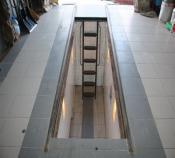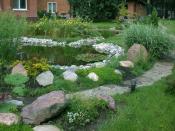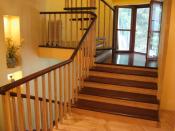Search
Login
DIY kitchen curtains
In the interior of modern kitchens, the design of curtains plays an important role. Not only the general view of the whole room, but also whether the family members and guests invited at the dining table will feel cozy on the curtains in the kitchen, will also depend.
Content
- Design curtains for the kitchen video
- Choice of fabric for kitchen curtains video
- Varieties of curtains for the kitchen video
Design curtains for the kitchen
The determining factor for choosing curtains for the kitchen is its interior design. And already depending on the style of the kitchen interior, curtains are selected.
If the kitchen is standard, small, decorated in the style of minimalism or in a modern style, then Roman curtains sewn from transparent or translucent, semi-synthetic or natural light fabric can be a good choice.

If the kitchen is large, made in the style of Art Deco, either in Victorian or in the English style, then you should give preference to curtains made of expensive heavy fabrics, possibly a dark shade. Such curtains are usually decorated without fail with lambrequins and voluminous tassels. Curtains look interesting on a beautiful, neat window. Currently, it is possible to supply cheap plastic windows. The company Bright Windows produces and installs high-quality PVC plastic windows in Moscow for the home and garden, and deals with glazing balconies and loggias. Quality assurance and durability.


The classic design of the kitchen window curtains, sewn from light colored fabrics, usually decorated with waves and draped with various ruffles. This is not only the most popular, but also an easy option for making beautiful curtains for the kitchen with your own hands.

For a kitchen made in the chalet style, as well as in the country or in the Russian style popular in our country, short curtains (about the length of about a window sill) made of light light semi-natural fabrics decorated with various images of all kinds of colors, animals and birds are an excellent choice also fruits, vegetables or berries, various national ornaments.

Sewing such curtains will not be difficult, you just need to choose the appropriate fabric to create the desired design.

Choice of fabric for kitchen curtains
Fabrics for curtains are selected depending on the style of the entire interior of the kitchen, taking into account both the size of the room itself and, in fact, the window that will decorate the selected kitchen curtains.
It should be borne in mind the natural lighting of the kitchen premises.
That is, if the kitchen is small in size, it is also located on the north side, which means it is dark, then you should not choose thick gloomy fabrics for drapery windows, it is better to choose material for curtains of translucent, light shades.
If the kitchen is spacious and located on the south side of the house, that is, it is lit well enough, then you can choose a dense fabric of dark color for sewing curtains.
And, of course, the color of the curtains must necessarily match both the color of the walls of the kitchen and furniture.

If you believe the theory about the influence of color on the quality of appetite, it is best to use fabric of cold shades of both light gray and muted blue to keep the figure fit for sewing curtains for the kitchen with your own hands.
And if your family does not have an overweight problem, you can safely choose orange, red or yellow fabrics, which are believed to improve appetite, as a material for sewing kitchen curtains.

When choosing fabric for kitchen curtains, also pay attention to whether it is resistant to pollution, whether the fabric is colored properly (does it fade, does it fade under direct sunlight), does it crumble (during sewing this will be one of the most important moments).
It is best to opt for interior textiles, which are distinguished by their dust- and dirt-repellent properties due to special impregnation, which also prevents its ignition and burning out.
You can pay attention to the linen fabric with the addition of a small amount of synthetic additives in order to make the curtain less wrinkled and better ironed after washing.
A good solution is the choice of fabric for kitchen curtains made of viscose with the addition of polyester additives.
The main quality characteristics of kitchen cloth should be practicality, safety and ease of maintenance and care.
Varieties of curtains for the kitchen
Roman curtains are the most popular kitchen curtains to date.
They are distinguished by both severity and clarity of the lines, and practicality along with convenience.
These fashionable beautiful curtains, undoubtedly, have earned their popularity due to their simplicity and functionality.
They are ideal for the interior of a small kitchen, for example, in Khrushchev, and for the spacious kitchen of a country house.
For their manufacture, special straight-shaped slats are used, two slats on one canvas (top and bottom) and a fabric of either moderately dense or translucent structure.

Roller blinds differ from Roman ones in that their fabric is wound on the shaft using a special device and, if necessary, such a curtain can be easily lowered or lifted using a simple mechanism.

In their manufacture, everything must be precisely calculated, providing also that they do not interfere with the opening and closing of the kitchen window.
In order to hang both Roman and roller blinds on the window, you can use the usual traditional curtains. As companions to them, you can also sew simple curtains from light plain fabric.

English curtains are usually sewn from striped fabric, or fabric with a Scottish cage, as well as using floral, floral or animal ornaments. Their feature is calm and muffled colors, as well as English nobility and simplicity of lines.

Italian curtains are easily attached both to the wall and to the ceiling, as well as to the window frame itself. Italian curtains are one of the most economical types of kitchen curtains, since the minimum amount of fabric, and, accordingly, the minimum amount of cash, is spent on their manufacture.

Japanese curtains are straight and even cloths, fixed with inserts of hard material. The insert located at the top is not fixed, but moves freely throughout the eaves, but the bottom is a kind of weighting agent.

The indisputable advantage of curtains in the Japanese style is that it is easy to remove, in order to undergo the necessary cleaning, and then hang it again.

Thus, with a great desire and insignificant skill, you can sew beautiful, and most importantly, one-of-a-kind, do-it-yourself kitchen curtains!






